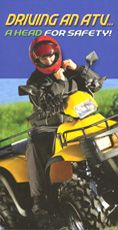|
|
Off-road vehiclesQuad
This legislation brought in rules governing the use of ATVs in order to counter the increasing number of serious accidents and deaths associated ATVs, which was casting a shadow over the extraordinary growth in the popularity of this type of vehicle. In fact, there were 308,422 of these vehicles licensed in Québec in 2005, with more than 16,000 kilometres of trails at their disposal. In 2006, the Act was amended to tighten the rules and improve coexistence between trail users and neighbouring residents. It is worth noting that almost all ATV accidents occur off the trails, and could be avoided by obeying the law and the safety rules. Safety helmetWearing a safety helmet is compulsory, not only on the trails, but everywhere and in all circumstances. The helmet must comply with the applicable standards, and must have a visor, failing which the ATV rider must wear safety goggles. The rider must also wear gloves and appropriate footwear. Minimum age and trainingThe Act sets 16 as the minimum age for operating this type of vehicle. In addition, riders aged 16 and 17 are required to take a training course and to hold a certificate of competence issued by the Fédération québécoise des clubs quads. All new riders should also take a training course. Speed limitUnless otherwise indicated, the speed limit for operating an ATV is 50 km/h. In addition, while this type of vehicle makes it possible to reach areas that are not easily accessible by other means, there are limitations to what an ATV can do, and ignoring these limitations can be fatal. PassengersIt is illegal to carry a passenger on an ATV, except in the case of a model that is specifically designed for two people by the manufacturer. Riding on public roads and driver’s permitIt is illegal to operate an ATV on a public road, except in the cases stipulated in the Act. This type of vehicle is not designed to be operated on pavement. In all cases, there must be a road sign indicating that ATV traffic is permitted. Permission can only be granted by the manager of the network (the MTQ or the municipality). It is also important to note that a valid driver’s licence is required in order to use a public road under the conditions set out in the Act. In addition, public roads can only be crossed at locations that are intended for this purpose and identified by traffic signs. Riding near inhabited areasIn general, it is illegal to operate an ATV within 30 metres of a dwelling, a health establishment, or an area that is reserved for cultural, educational, or sports activities without having obtained the express permission of the property owner. There are some exceptions, and the allowable speed limit in these cases is 30 km/h. InsuranceEvery owner of an all-terrain vehicle must hold a minimum of $500,000 of third-party liability insurance. Pursuant to the Automobile Insurance Act, the Société de l’assurance automobile du Québec (SAAQ) does not compensate ATV riders for accidental injuries unless a moving automobile is involved. It is recommended that ATV owners take out a personal insurance policy that provides coverage for bodily injury and property damage. Mandatory equipmentThe vehicle must be equipped with a white headlight, a red tail-light, and exhaust and braking systems. Models manufactured after January 1, 1998 must also be equipped with a red rear brake light, a rear-view mirror that is firmly attached to the left side of the vehicle, and a speedometer. Modifying or removing this equipment is strictly prohibited. Riding on iceIf you must drive on a lake or river in winter, stick to marked areas that are patrolled by a club. Crossing a body of water in early or late winter is particularly risky, especially in unmarked areas. Obstacles that are hidden by snow, such as docks, can become deathtraps, especially at night. Survival kitBe prepared, and carry a basic survival kit that includes the following items:
There is no guarantee that a cell phone will be reliable outside of urban areas or far from major road corridors. Therefore, it is a good idea to carry a topographic map. It may also be useful to bring along a GPS receiver (satellite tracking system/global positioning system) to help you find your way in the woods. Other trail usersRegardless of the season, it is important to pay special attention to the safety of other trail users, especially hikers, cross-country skiers, and snowshoers. Trail security officersTrail security officers are volunteers who patrol the trails in order to make ATV riders aware of the importance of obeying the law and practicing safe behaviour. Their work requires know-how and dedication, and they deserve your respect and your complete cooperation. Respecting the environmentObviously, respecting the environment means respecting nature and wildlife, but it also means respecting the peace and quiet of neighbouring residents. Staying on the trails is the best way to do your part. Respecting property rightsATV riders sometimes damage the fences that are installed by the MTQ along road rights-of-way in order to travel off the trails that are set aside for them, and operate illegally on public roads. Remember that fences and other installations are there for a reason, and are intended to ensure your safety and that of road users. WayleavesBefore riding an ATV on private property, you must obtain permission from the owner. Riding off-trail without permission is likely to disturb the property owners, which will reduce the chances that wayleaves will be granted. Riding on private property without permission from the owner or lessee is subject to a fine of $250 to $500. In addition, the MTQ encourages ATV riders to stay on the marked trails that are maintained by their federation. Club volunteers are responsible for obtaining wayleaves on the trails that are operated by the Fédération québécoise des clubs quads. The Act respecting off-highway vehicles provides for the following fines:
|
|||||||||||||||||||||||||||||||||||||||||||||||||


